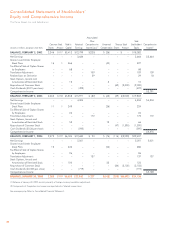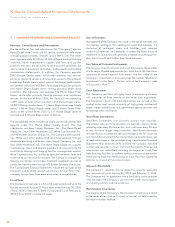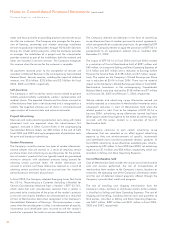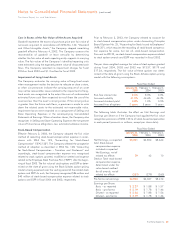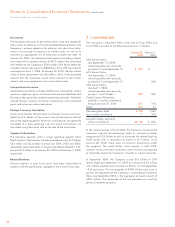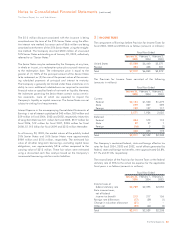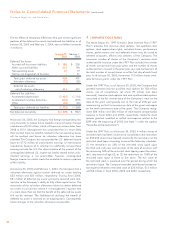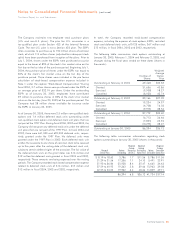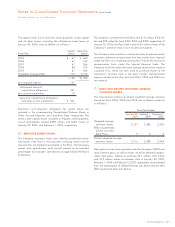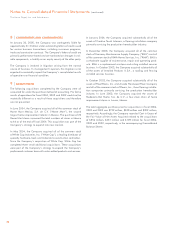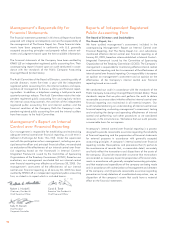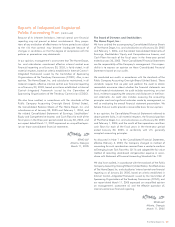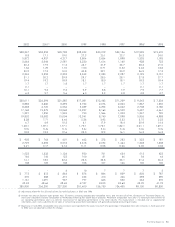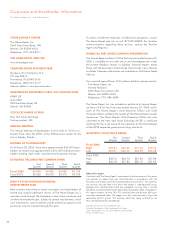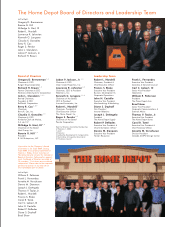Home Depot 2004 Annual Report Download - page 38
Download and view the complete annual report
Please find page 38 of the 2004 Home Depot annual report below. You can navigate through the pages in the report by either clicking on the pages listed below, or by using the keyword search tool below to find specific information within the annual report.
Notes to Consolidated Financial Statements (continued)
The Home Depot, Inc. and Subsidiaries
36
5|LEASES
The Company leases certain retail locations, office space,
warehouse and distribution space, equipment and vehicles. While
most of the leases are operating leases, certain locations and
equipment are leased under capital leases. As leases expire, it can
be expected that, in the normal course of business, certain leases
will be renewed or replaced.
Certain lease agreements include escalating rents over the lease
terms. The cumulative expense recognized on a straight-line basis
in excess of the cumulative payments is included in Other Accrued
Expenses on the accompanying Consolidated Balance Sheets.
The Company has a lease agreement under which the Company
leased assets totaling $282 million. The lease was created as a
subsequent lease to an initial lease of $600 million. These two
leases were originally created under structured financing arrange-
ments and involve three special purpose entities. The Company
financed a portion of its new stores opened in fiscal years 1997
through 2003, as well as a distribution center and office buildings,
under these lease agreements. Under both agreements, the lessor
purchased the properties, paid for the construction costs and
subsequently leased the facilities to the Company. The Company
records the rental payments under the terms of the operating lease
agreements as Selling and Store Operating Expenses in the
accompanying Consolidated Statements of Earnings.
In December 2003, the Company exercised its option to purchase
the assets under the initial lease agreement of $600 million at the
original cost of the assets of $598 million, which approximated fair
market value. These assets are included in the accompanying
Consolidated Balance Sheets in Property and Equipment and are
being depreciated on a straight-line basis over their estimated
remaining useful lives. In connection with the purchase of the
assets, one of the aforementioned special purpose entities was
dissolved, leaving two special purpose entities.
The lease term for the remaining $282 million agreement expires in
2008 with no renewal option. The lease provides for a substantial
residual value guarantee limited to 79% of the initial book value
of the assets and includes a purchase option at the original cost of
each property. As the leased assets were placed into service, the
Company estimated its liability under the residual value guarantee.
The maximum amount of the residual value guarantee relative to
the assets under the off-balance sheet lease agreement described
above is estimated to be $223 million. Events or circumstances that
would require the Company to perform under the residual value
guarantee include (1) initial default on the lease with the assets sold
for less than book value, or (2) the Company’s decision not to
purchase the assets at the end of the lease and the sale of the assets
results in proceeds less than the initial book value of the assets.
In the first quarter of fiscal 2004, the Company adopted the
revised version of FASB Interpretation No. 46, “Consolidation of
Variable Interest Entities” (“FIN 46”). FIN 46 requires consolidation
of a variable interest entity if a company’s variable interest
absorbs a majority of the entity’s expected losses or receives a
majority of the entity’s expected residual returns, or both.
In accordance with FIN 46, the Company was required to consol-
idate one of the two remaining aforementioned special purpose
entities that, before the effective date of FIN 46, met the require-
ments for non-consolidation. The second special purpose entity
that owns the assets leased by the Company totaling $282 million
is not owned by or affiliated with the Company, its management
or its officers. Pursuant to FIN 46, the Company was not deemed
to have a variable interest, and therefore was not required to
consolidate this entity.
FIN 46 requires the Company to measure the assets and liabilities
at their carrying amounts, which amounts would have been
recorded if FIN 46 had been effective at the inception of the trans-
action. Accordingly, during the first quarter of 2004, the Company
recorded Long-Term Debt of $282 million and Long-Term Notes
Receivable of $282 million on the Consolidated Balance Sheets.
The Company continues to record the rental payments under the
operating lease agreements as Selling and Store Operating
Expenses in the Consolidated Statements of Earnings. The adoption
of FIN 46 had no economic impact on the Company.
Total rent expense, net of minor sublease income for fiscal 2004,
2003 and 2002 was $684 million, $570 million and $533 million,
respectively. Certain store leases also provide for contingent rent
payments based on percentages of sales in excess of specified
minimums. Contingent rent expense for fiscal 2004, 2003 and
2002 was approximately $11 million, $7 million and $8 million,
respectively. Real estate taxes, insurance, maintenance and operat-
ing expenses applicable to the leased property are obligations of the
Company under the lease agreements.


